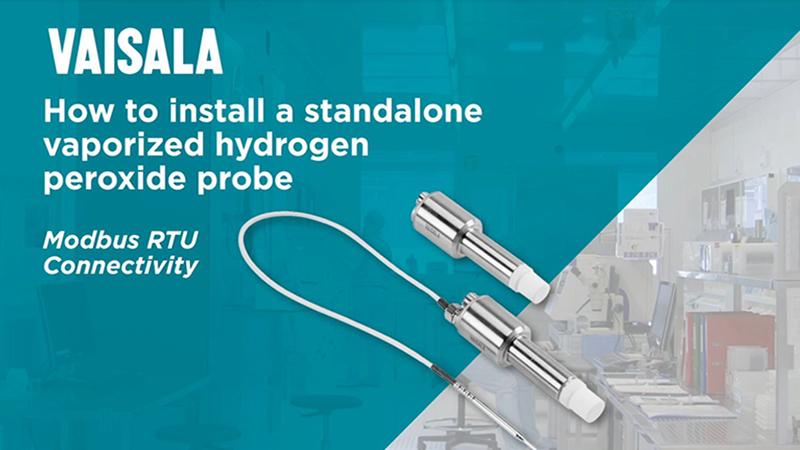In this video blog, product engineer Joni Partanen demonstrates how to connect the HPP270 vaporized hydrogen peroxide probe using a Modbus protocol. Modbus is a communication protocol used for transmitting information over serial lines between electronic devices. The device requesting the information is called the Modbus Master and the devices supplying information (in this case, the HPP270 probe) are Modbus Slaves.
Vaisala’s HPP272 probe can communicate by using Modbus RTU digital communication. If Modbus is new to you, this video will show you how to get started. You will need a USB cable to communicate with the probe and
Vaisala’s Insight PC software. This cable can also be used for demonstrating and testing RS485 communication protocol, which the Modbus RTU was built on.
We’ll take a PC with Insight software installed, cable, and connect our probe. The Insight software detects the probe automatically. But first, we’ll find the COM port that this probe is connected to.
Open the device manager in Windows and find the ports under: COM & LPT. There you will find the Vaisala device. In my computer’s configuration, it’s COM 11. You will probably have a different COM port. We will also need our
HPP270 probe User Guide. Now we need a program that can use the Modbus protocol to communicate with the probe. You can find the tools we discuss in this video at
modbus.org/ under
Technical Resources.
The particular tool you use is up to you. I will use the
modpoll tool, which is a command line based Modbus master simulator and test utility. I have already installed this program on my computer. In a command prompt screen, typing “modpoll -h” will bring up a Help section. Now, I will refer to my HPP270 user guide.
I’m going to create the communication settings. In my command prompt, I type in Modpoll, then “-m rtu”, “-a” for address. The default address of the probe is 240. Now I will adjust the parity. The default parity is even, but this Modbus protocol is actually using none. So let's change that; type “-p none”. We then adjust the stop bits “-s 2”. And to check the registers we want to read, we turn back to the HPP270 user guide.
Here is an advantage of the Modbus protocol: with analog outputs, we can output only two values. But, as you can see from the address mapping in our user guide, there are many different parameters available in the HPP270 probe. So. let's read several different values.
We start with register one “-r 1”. We will read six values “-c 6” These are floating point numbers, so “- t 4:float” We are now reading holding registers (Modbus protocol defines a holding register as 16 bits wide.)
So now we enter the right COM port (COM11 in this case).
Now we have some values, but we don’t yet have all the values. We see that the third register gives a value for temperature. The reason we don’t yet have all the values is that the probe is currently in purge mode. How do we know that? We also can get that information from the probe using Modbus and our user guide.
Starting from register 513 in the user guide under the section: Modbus Status registers. Because we want to read integer values here and the first register is 16 bits, but the second and third registers are 32 bits.
So with this command we see that there is some kind of notification. In the user guide we go to Table 17– Error Codes 0203 hex 32 bit) to find what the 516 register tells us. And we see that a purge is in progress. We’ll wait until the purge process is completed, then we can read the other values.
NOTE: It takes approximately four minutes to complete a probe purge process. Probe purge is recommended at least every 24 hours of powered-on time, even if the probe has not been continuously exposed to H2O2. If needed, the purge process can be triggered at any time using Vaisala Insight software, Modbus (in digital mode), or pin #5 on the M12 connector (in analog mode).
Now that the purge is complete, it’s time to read the measurement values. In the user guide, we will turn to Section A.4.1 – Measurement data registers (Table 13), which allows us to match the register number to the unit of measurements.
In register 1, vaporized hydrogen peroxide is 7.985 ppm; register 3 shows the relative saturation is 16.107; register 5 shows temperature is 24.64 °C; register 7 shows the relative humidity is currently the same as relative saturation, 15.91 RH%. Register 9 shows the absolute hydrogen peroxide value 11 mg/m3 and register 11 shows mixture dew point temperature at -1.9 °C. These are useful parameters....
The Modbus protocol is quite handy because you can get all these parameters digitally. The next step would be to implement this communication in your Programmable Logic Controller system (PLC), or other control system. I recommend that you consider Modbus communication with the HPP270 probe because it allows you to control the purge process, get all the necessary parameters, and status signals from the measurement probe.
If you have any questions, please leave them in the comments below. Or
contact us...In our next video blog, learn how to connect the HPP270 probe with analog communications.






Comment
Add new comment